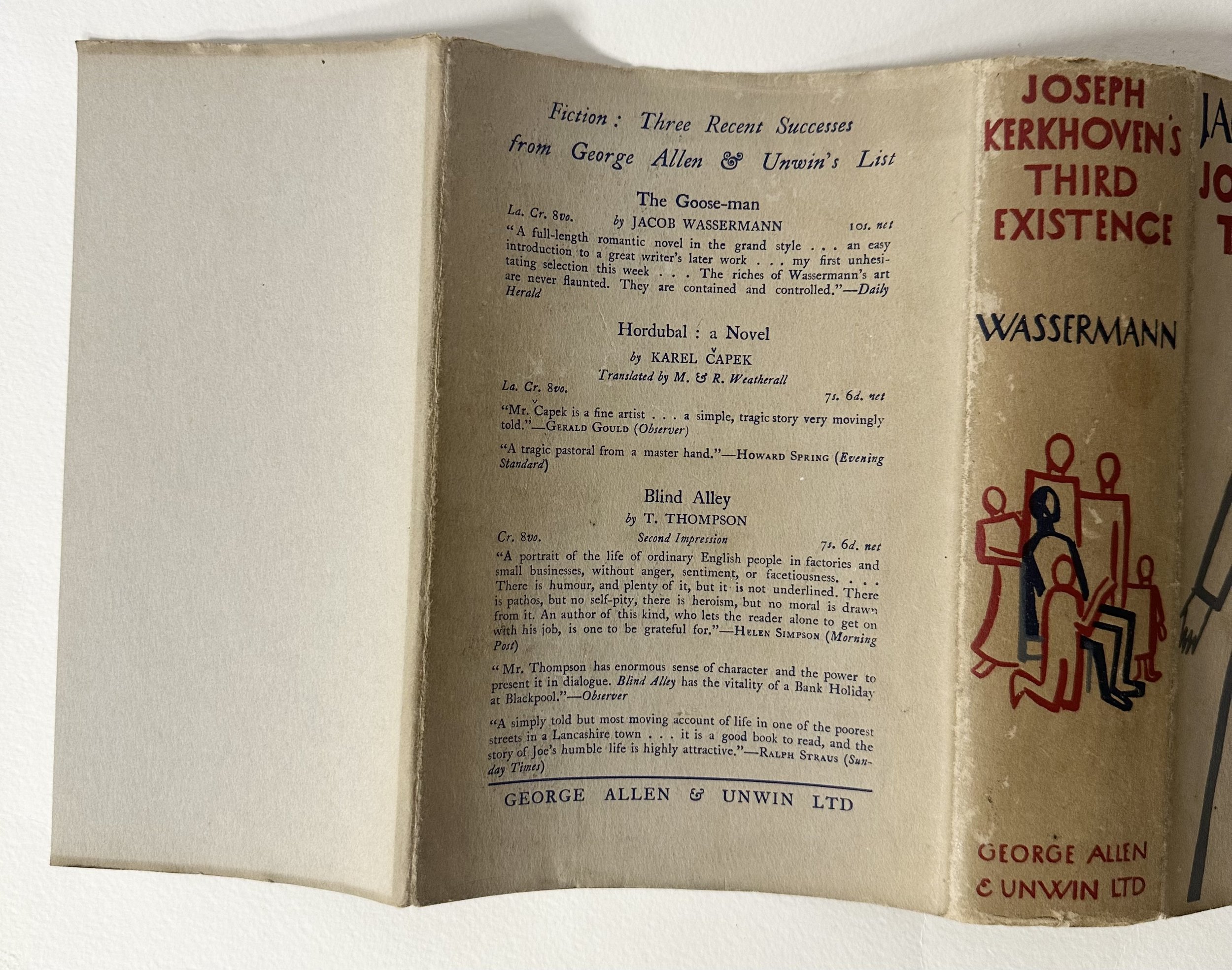 Image 1 of 5
Image 1 of 5

 Image 2 of 5
Image 2 of 5

 Image 3 of 5
Image 3 of 5

 Image 4 of 5
Image 4 of 5

 Image 5 of 5
Image 5 of 5






WASSERMANN, Jacob. Joseph Kerkhoven's Third Existence
WASSERMANN, Jacob. Joseph Kerkhoven's Third Existence. Trans. from the German by Eden and Cedar Paul. London: George Allen and Unwin. 1934. 8vo. First English language edition. Publisher’s blue cloth lettered in black to the spine, in the wonderful dust jacket designed by Margaret Macadam. A near fine example, the cloth clean and bright, the binding square and perhaps just slightly slack from the size of the volume. Some light stains and faint spots to the textblock edges, the contents generally fine but for ink ownership signature to the front endpaper and small nibbles just above, minor. The dust jacket price-clipped, the corners and spine tips just a little rubbed with a few very small nicks. A handsome example.
Posthumously published (just), this is the German Wassermann’s third novel in a loose trilogy or saga which, says the front flap, can equally be considered standalone—it follows a disastrous marriage and the downfall of a man enduring love lost, based supposedly on Wassermann’s first marriage. Wassermann enjoyed critical and commercial success in the 1920s and early 30s across Germany, but the rise of the Nazis became a growing threat, and in his final years, his books were banned and his freedoms shackled owing to his Jewish heritage. His dense, philosophical, sometimes dream-like writing style was likened to Stefan Zweig and Arthur Schnitzler in his time.
The terrific dust jacket is by Margaret Macadam, much of whose work had been uncredited until the discovery of her archive in 2016. She produced a generally small but exquisite portfolio of commercial art, and only a small handful of dust jackets, most notably for Agatha Christie’s pseudonymous Giant’s Bread, published in 1930 under her Mary Westmacott nom-de-plume. Her style here and in her other work is not dissimilar to the work of Edward McKnight-Kauffer, who was a known influence on Macadam. Scarce.
WASSERMANN, Jacob. Joseph Kerkhoven's Third Existence. Trans. from the German by Eden and Cedar Paul. London: George Allen and Unwin. 1934. 8vo. First English language edition. Publisher’s blue cloth lettered in black to the spine, in the wonderful dust jacket designed by Margaret Macadam. A near fine example, the cloth clean and bright, the binding square and perhaps just slightly slack from the size of the volume. Some light stains and faint spots to the textblock edges, the contents generally fine but for ink ownership signature to the front endpaper and small nibbles just above, minor. The dust jacket price-clipped, the corners and spine tips just a little rubbed with a few very small nicks. A handsome example.
Posthumously published (just), this is the German Wassermann’s third novel in a loose trilogy or saga which, says the front flap, can equally be considered standalone—it follows a disastrous marriage and the downfall of a man enduring love lost, based supposedly on Wassermann’s first marriage. Wassermann enjoyed critical and commercial success in the 1920s and early 30s across Germany, but the rise of the Nazis became a growing threat, and in his final years, his books were banned and his freedoms shackled owing to his Jewish heritage. His dense, philosophical, sometimes dream-like writing style was likened to Stefan Zweig and Arthur Schnitzler in his time.
The terrific dust jacket is by Margaret Macadam, much of whose work had been uncredited until the discovery of her archive in 2016. She produced a generally small but exquisite portfolio of commercial art, and only a small handful of dust jackets, most notably for Agatha Christie’s pseudonymous Giant’s Bread, published in 1930 under her Mary Westmacott nom-de-plume. Her style here and in her other work is not dissimilar to the work of Edward McKnight-Kauffer, who was a known influence on Macadam. Scarce.
